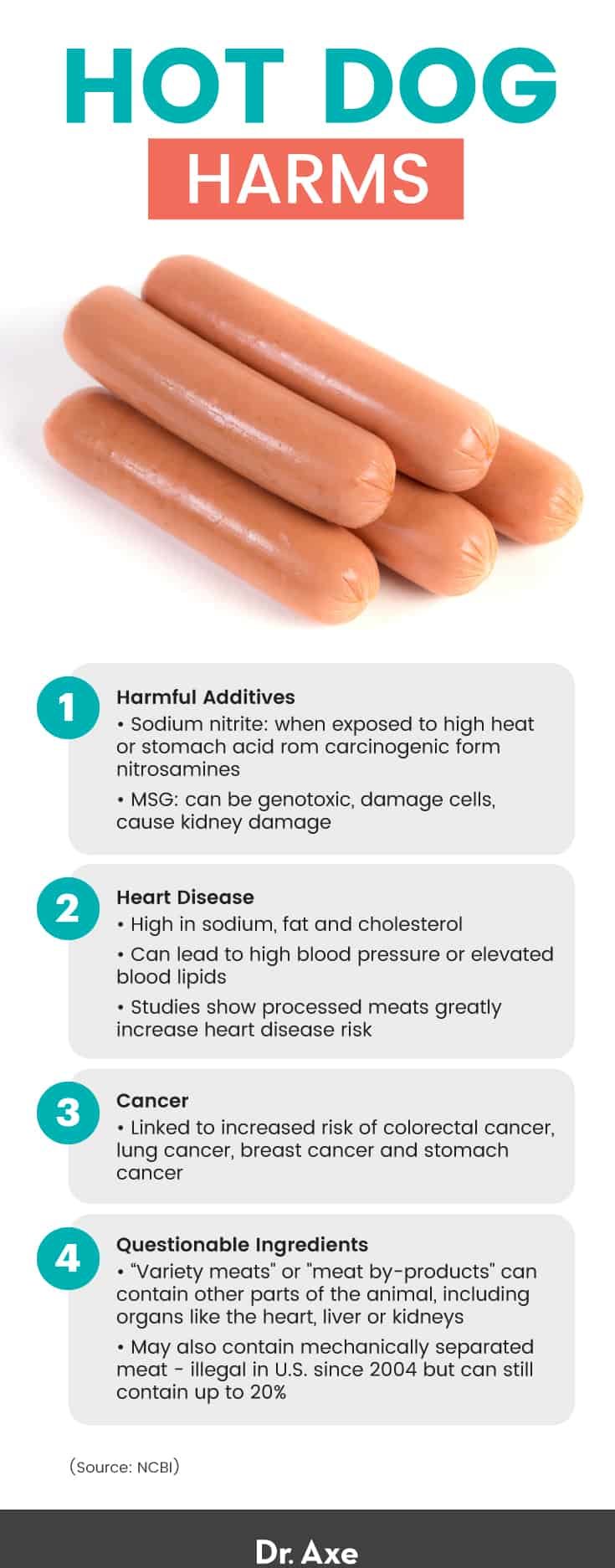
Study: Eating 1 Hot Dog Can Take 36 Minutes Off Your Life
Christine Ruggeri, CHHC via Dr. Axe – Frequently found everywhere from hot dog stands on the street corners to summertime barbecues and picnics, hot dogs are a popular food eaten around the world, but a recent study found that eating just one beef hot dog can result in the loss of 36 minutes of healthy life.
The standard hot dog is made from the trimmings of beef and pork, which are ground up and blended up into a batter along with additional ingredients, like seasonings, curing ingredients and sodium nitrite to help boost both shelf life and color. This mixture then goes into a machine that pumps them into cellulose casings that are then cooked, doused in cold water and packaged into the individual links that you find at the grocery store.
While hot dogs may be a go-to favorite for many when it comes time to fire up the grill, they may not make the healthiest addition to your diet. In fact, these recent findings suggest that eating them will reduce your healthy life span.
Not only are hot dogs highly processed meat and filled with potentially harmful chemicals like nitrates, nitrites and MSG, but there have also been a series of hot dog recall warnings that call into question the safety of your favorite frankfurter.
Hot Dog Study Findings
A new 2021 study published in the journal Nature Food analyzed over 5,800 foods in the American diet and measured their potential effects on life span. The team of researchers at the University of Michigan designed an index that calculates the net detrimental or beneficial burden in minutes of life that’s associated with a particular food.
The index measured exactly how many minutes are deducted or added to life after the consumption of certain foods, like processed meats, nuts, fruits and vegetables.
Using this index, researchers found that a standard beef hot dog on a bun results in healthy life loss of 27 minutes, but when ingredients such as trans fats and sodium are factored in to the equation, eating a hot dog can reduce healthy life by 36 minutes, according to study findings.
Other Hidden Dangers
The bone-chilling details of this recent hot dog study aren’t the only reason you should probably consider cutting back on your hot dog consumption. Besides the potential risk for contamination with bones, metal shards and foodborne illness, there are also some other negative health effects and hidden dangers of hot dogs that should be considered.
1. Made with Harmful Additives
Hot dogs contain several food additives that could be detrimental to your health. Sodium nitrite, for example, is commonly added to processed meats, such as hot dogs, bacon and ham, to act as a preservative, block bacteria growth and enhance the color.
Though nitrites themselves are generally not harmful, research suggests that when they are exposed to high heat or the acidity of the stomach, they can form nitrosamines, which are considered carcinogenic.
Monosodium glutamate, or MSG, is another additive frequently found in processed meats and used to enhance flavor. Some studies have found that MSG can be genotoxic, meaning it causes damage to our cells, while other studies have shown that chronic MSG consumption has caused kidney damage in animals.
Additionally, although there is limited scientific evidence on MSG sensitivity, there are many anecdotal reports of experiencing symptoms like headaches, hives, congestion and chest pain following MSG consumption.
2. Increased Risk of Heart Disease
Hot dogs tend to be high in sodium, fat and cholesterol. Excessive consumption can lead to problems like high blood pressure or elevated blood lipids, which can increase your risk of heart disease.
Additionally, hot dogs are highly processed foods. Processed meats have repeatedly been linked to a higher heart disease risk.
For example, a 2014 study found that eating more processed red meat led to a higher risk of heart failure.
Another study in the journal Public Health Nutrition found that each serving of processed meat boosted the risk of heart disease mortality by 15 percent.

3. Increased Risk of Cancer
The World Health Organization made a splash by publishing a report classifying processed meats, such as hot dogs, as “carcinogenic to humans,” right alongside harmful compounds like tobacco and asbestos. This conclusion was based on multiple studies that have established a clear linkbetween consumption of processed meats, like hot dogs, and an increased risk of certain types of cancer.
For example, a 2014 study grouped participants into categories based on their processed meat consumption. Data indicates that those with the highest intake of processed meats had a 22 percent higher risk of colorectal cancer than those with the lowest intake, and each 100-gram increase in intake was linked to a 14 percent higher risk.
Other studies have also found an association between high consumption of processed meat and a higher risk for breast, lung and stomach cancer.
4. Questionable Ingredients
It’s not uncommon to see hot dog recalls making news headlines. In 2017, the company that makes hot dogs for popular brands like Nathan’s announceda hot dog recall due to the presence of tiny shards of metal found in the packaging.
Only one year before that, another hot dog recall notice was issued because of listeria contamination.
A more recent hot dog recall, however, may make you rethink your menu for your next summer barbecue. The maker of Sabrett hot dogs recalled more than 7 million pounds of hot dogs and sausages after finding that they contained bone fragments that caused minor injuries to at least one person.
Once you understand the process of how hot dogs are made, it’s not hard to imagine how this type of contamination could easily occur. Throw a bunch of meat trimmings into a blender and you’re bound to get the occasional bone or shard of metal, along with who knows what else.
There are other possible unsavory hidden ingredients that could be lurking in your hot dog as well. For example, if you’re browsing the hot dog aisle and see a package that reads “variety meats” or “meat by-products,” that means that it can contain other parts of the animal, including organs like the heart, liver or kidneys.
To avoid these ingredients, stick to brands that contain “all meat,” such as “all turkey” or “all beef.”
Additionally, hot dogs may also contain mechanically separated meat, or MSM. This is a type of meat that has been pushed through a sieve to separate the meat from the bone, creating a type of paste.
While this process was made illegal in the United States in 2004 due to its association with mad cow disease, regulations now state that hot dogs can still contain up to 20 percent MSM.
5. May Cause Allergic Reaction
Some people have reported allergic reactions or negative symptoms after eating hot dogs. Hot dogs typically contain a long list of ingredients, so it can be hard to pinpoint exactly which ingredients may be to blame for these symptoms.
While it can sometimes be an allergy to the specific kind of meat used, it is more often an allergy resulting from one of the additives or dyes found in hot dogs. Nitrates, annatto seed, carmine and tartrazine are a few of the ingredients that are often responsible for adverse reactions after eating hot dogs.
Like all foods, you should stop eating hot dogs immediately and consult your doctor if you experience any negative symptoms.
What Are Hot Dogs Made Of?
There are a few basic steps to making hot dogs, although some of the spices and order of steps vary according to where the dogs will be sold. That’s right, according to the people at hot dog manufacturing facilities, where the dogs are sold dictates how they taste as people in different regions have different preferences when it comes to their hot dogs.
In general, the following steps explain how hot dogs are made and what they’re made of:
- Trimmings are raked into stainless steel cases. (Trimmings are what’s left over after cutting up steaks and pork chops.)
- The trimmings are next dumped into a chopper where they are chopped.
- Water, salt, corn syrup or sorbitol, food starch, and liquid smoke are added.
- All ingredients are blended in a large vat.
- Secret spices are now added. These vary based on where the hot dogs will be sold.
- Sodium nitrate is added for extending shelf life and color enhancement.
- The meat mixture is put through a funnel and comes out the other end looking a lot like what a meat smoothie would resemble.
- The dogs are stuffed into cellulose tubing and cut every 5 ¼ inches.
- The now closed hot dogs are baked.
- The cooked hot dogs are doused in cold, salty water and packaged.
As the popularity of hot dogs has grown, more and more types of hot dogs have hit the shelves. In addition to the standard beef and pork franks, other types of hot dogs include turkey, chicken and cheese-filled hot dogs, as well as deep-fried corn dogs.
Hot dogs are also available in reduced-fat, all meat, nitrite-free and even vegetarian varieties.
Though some of these types may be preferential over the standard fat-filled, sodium-rich hot dogs, they should all still be consumed only in moderation. Vegetarian hot dogs (also cleverly dubbed “not dogs”), for example, may be lower in cholesterol and fat than regular hot dogs, but they are still highly processed and usually contain a long list of questionable ingredients, like soy and textured vegetable protein.
Nutrition Facts
The nutrients found in hot dogs can vary based on the brand, the type of meat used and the toppings that are added. However, most hot dogs tend to be high in sodium and cholesterol, as well as saturated fat.
They also are usually low in carbohydrates and provide a moderate amount of protein, with anywhere from five to eight grams of protein per serving.
For reference, one beef frankfurter (about 45 grams) contains approximately:
- 148 calories
- 2.1 grams carbohydrates
- 5.1 grams protein
- 13 grams fat
- 513 milligrams sodium (21 percent DV)
- 0.8 micrograms vitamin B12 (13 percent DV)
- 24 milligrams cholesterol (8 percent DV)
- 72 milligrams phosphorus (7 percent DV)
- 1.1 milligrams zinc (7 percent DV)
- 1.1 milligram niacin (5 percent DV)
- 3.7 micrograms selenium (5 percent DV)
- 16.2 international units vitamin D (4 percent DV)
- 0.1 milligram riboflavin (4 percent DV)
- 0.7 milligrams iron (4 percent DV)
- 0.1 milligram copper (4 percent DV)
Note that this is the nutrient information for a beef hot dog with no toppings or bun. Adding a bun can increase the hot dog calories by about 120, while considerably increasing the carbohydrate and sodium content as well.
Meanwhile, any additional toppings or condiments, like ketchup or mustard, will increase your hot dog calories even more depending on how much is used.
Healthier Alternatives
If you’re a big fan of hot dogs and can’t imagine hosting a barbecue without them on the menu, there are ways to make your hot dog a bit healthier.
Check your local grocery stores for “all meat” and “nitrite-free” hot dog varieties. Additionally, practice label reading, and look for a brand that is lower in sodium, saturated fat and calories with minimal ingredients listed.
Remember that those extra toppings can stack up fast and may even provide more calories and sodium than the actual hot dog itself. Keep toppings like cheese, pickles and sauerkraut in check, and consider swapping these for healthier choices like avocado, tomatoes, cabbage or raw onions.
Then finish it off with a whole-wheat bun rather than a white bun to make sure you’re maximizing your nutrient intake.
There are also hot dog alternatives available at the grocery store, like chicken sausage and turkey dogs. Of course, make sure to check the ingredients on these products also to rule out unhealthy additives.
Finally, keep in mind that even the healthiest hot dog at the grocery store is still processed. Ideally, you should avoid hot dogs completely.
If you do want to enjoy the occasional hot dog from time to time, moderation should be key.
Conclusion
- Unsurprisingly, hot dogs are hardly considered a health food thanks to their high amount of sodium, cholesterol and saturated fat coupled with their long list of highly processed ingredients. Because of the way that hot dogs are made, they also present an increased risk of contamination and really should be avoided. If you need further proof, look no further than the long list of hot dog recall reports and the recent study that consuming just one can take time off your life.
- While there are plenty of healthy hot dog alternatives and ways to improve the nutrient profile of your frankfurter, they should still be enjoyed only in moderation.
- Chowing down on a hot dog or two at your annual Fourth of July party is one thing, but including them as a regular part of your diet could lead to some seriously negative effects on your health.
To read the original article click here.






